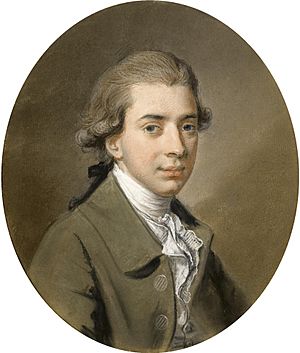Hugh Douglas Hamilton facts for kids
Quick facts for kids
Hugh Douglas Hamilton
|
|
|---|---|
| Born | c. 1740 Dublin, Ireland
|
| Died | 10 February 1808 (aged 67–68) Dublin, Ireland
|
Hugh Douglas Hamilton (born around 1740 – died February 10, 1808) was a famous Irish artist. He was known for painting portraits. He spent many years living and working in London and Rome. Later, in the early 1790s, he moved back to his hometown of Dublin, Ireland. For a long time, until the mid-1770s, he mostly used pastels to create his artworks. His unique painting style even influenced another English painter named Lewis Vaslet.
Contents
Life Story
Hugh Hamilton was born in 1740 in Crow Street, Dublin, Ireland. His father made perukes, which were fancy wigs. We don't know much about Hugh's early life, except for what his own drawings show us. He studied art at the Dublin Society House. His teachers were Robert West and James Mannin. He quickly became good at drawing with crayons and pastels. He also made friends with important people who could help his career. One of these was the wealthy La Touche banking family in Dublin. They had strong connections with the Bank of Ireland.
Early Years and London Success
Not much is known about Hamilton's work between 1756 and 1764. In 1764, he moved to London, England. There, he became very successful with his oval-shaped pastel portraits. He painted many important people, including kings, queens, politicians, and famous individuals of the time. Hamilton often had so many orders that he was overwhelmed! He even painted for the British royal family. Examples include his portrait of Queen Charlotte from 1764. These paintings are now part of the British Royal Collection. He showed his art at the Society of Artists and the Free Society of Artists from the mid-1760s to the mid-1770s. After the mid-1770s, Hamilton became very interested in a new way of using pastels. He blended crayons and chalk to make his pastel portraits look softer and more like real skin.
Time in Italy
In 1779, Hamilton traveled to Italy. He stayed there for the next twelve years. Sometimes he visited Florence, but he mostly lived in Rome. In Rome, he became friends with the famous sculptor Antonio Canova. An artist named John Flaxman advised Hamilton to try oil painting. Hamilton followed this advice and became very good at painting small, oval oil portraits. He painted many Irish and British visitors who were traveling in Italy. Some of his famous portraits from this time include Dean Kirwan (which you can see at the Royal Dublin Society), George John, 2nd Earl Spencer, Countess Cowper (1787), and Charles Edward Stuart (Lord Edward, 1785), who was living away from his home country. His painting of Susan Frances Elizabeth (Anne) Butler, Countess of Ormonde, can be seen at Kilkenny Castle.
Return to Dublin
In 1791, Hamilton returned to Dublin, where he later passed away. In 1796, he painted Lord Edward Fitzgerald, an important Irish leader who wanted change. One of his last paintings, from around 1804, is of William Downes, 1st Baron Downes. He was a very important judge in Ireland. This portrait is considered one of Hamilton's best works.
Painting Style and How He Did It
Hamilton was most famous for his oval pastel portraits. These paintings usually showed only the head and shoulders of the person. These pastel portraits were lively and not too expensive, costing about six guineas each. That was a fair bit of money back then! They became very popular all over Europe. For these oval portraits, Hamilton used special handmade paper. It was usually cream or off-white and medium thick. It was also treated with a type of glue called gelatin glue. We don't know exactly how Hamilton prepared his paper. However, it's thought that he didn't make sketches beforehand. He usually finished the portraits in one sitting while the person was right there. This speed and skill were very important because Hamilton had so many people wanting his portraits.
His Unique Pastel Method
There are no written records from Hamilton himself about how he used pastels. But by carefully looking at his paintings, art experts and conservators have been able to figure out some of his methods. Hamilton probably put each color on the portrait separately. Then he would blend them. This helped to keep the colors bright and clear. He used pastel sticks both wet and dry. When he drew a face, he first outlined the head and shoulders with a light color. Then he added the features of the face using light reddish colors. After that, he blended the colors on the face with his fingers. Next, he filled in the background using the wide side of the pastel stick, being careful to avoid the outline of the face. Finally, he used the last strokes of pastel to add loose hair and other small details. He then used a pencil (graphite) to draw tiny details like eyelashes. Hamilton's painting method stayed pretty much the same throughout his career. It was influenced by European art traditions and what people wanted to buy.


